The Effect of Plasma Pretreatment and Cross-Linking Degree on the Physical and Antimicrobial Properties of Nisin-Coated PVA Films
Abstract
1. Introduction
2. Materials and Methods
2.1. Materials
2.2. PVA Films Preparation
2.3. PVA Activation and Nisin Application
2.4. Release and Stability Analysis of Nisin
2.5. Antimicrobial Assays
2.6. Surface Characterization
2.6.1. Wettability and Surface Energy Analysis
2.6.2. Elektrokinetic Characterization
2.6.3. XPS Analysis
3. Results
3.1. Stability Analysis of Nisin
3.2. Nisin Release
3.3. Antimicrobial Assays
3.4. Wettability and Surface Energy Analysis
3.5. Electrokinetic Characterization
3.6. XPS Analysis
4. Conclusions
Author Contributions
Funding
Acknowledgments
Conflicts of Interest
References
- Cho, D.; Hoepker, N.; Frey, M.W. Fabrication and characterization of conducting polyvinyl alcohol nanofibers. Mater. Lett. 2012, 68, 293–295. [Google Scholar] [CrossRef]
- Bosco, R.; Edreira, E.U.; Wolke, J.G.; Leeuwenbugrh, C.G.; Van Den Beucken, J.; Jansen, J.A. Instructive coatings for biological guidance of bone implants. Surf. Coat. Technol. 2013, 233, 91–98. [Google Scholar] [CrossRef]
- Hrabalikova, M.; Merchan, M.; Ganbold, S.; Sedlarik, V.; Valasek, P.; Saha, P. Flexible polyvinyl alcohol/2-hydroxypropanoic acid films: effect of residual acetyl moieties on mechanical, thermal and antibacterial properties. J. Polym. Eng. 2015, 35, 319–327. [Google Scholar] [CrossRef]
- Yin, H.; Mix, R.; Friedrich, J.F. Combination of plasma-chemical and wet-chemical processes-a simple way to optimize interfaces in metal-polymer composites for maximal adhesion. J. Adhes. Sci. Technol. 2011, 25, 799. [Google Scholar]
- Ducheyne, P.; Healy, K.; Dietmar, E.; Hutmacher, E.; Grainger, D.W.; Kirkpatrick, C.J. Comprehensive Biomaterials. Available online: https://www.elsevier.com/books/comprehensive-biomaterials/ducheyne/978-0-08-055302-3 (accessed on 13 August 2018).
- Ryder, M.; Schilke, K.F.; Auxier, J.A.; McGuire, J.; Neff, J. Nisin adsorption to poly-ethylene oxide layers and its resistance to elution in the presence of fibrinogen. J. Colloid Interface Sci. 2010, 350, 194–199. [Google Scholar] [CrossRef] [PubMed]
- Duan, J.; Park, S.I.; Daeschel, M.A.; Zhao, Y. Antimicrobialchitosan Lysozyme (CL) films and coatings for enhancingmicrobial safety of Mozzarella cheese. Food Microbiol. Saf. 2007, 72, 355–361. [Google Scholar]
- Saraf, A.; Johnson, K.; Lind, M.L. Poly(vinyl) alcohol coating of the support layer of reverse osmosis membranes to enhance performance in forward osmosis. Desalination 2014, 333, 1–9. [Google Scholar] [CrossRef]
- Xiang, C.; Taylor, A.G.; Hinestroza, J.P.; Frey, M.W. Controlled release of nonionic compounds from poly (lactic acid)/cellulose nanocrystal nanocomposite fibers. J. Appl. Polym. Sci. 2013, 127, 79–86. [Google Scholar] [CrossRef]
- Karam, L.; Jama, C.; Dhulster, P.; Chibib, N. Study of surface interactions between peptides, materials and bacteria for setting up antimicrobial surfaces and active food packaging. J. Mater. Environ. Sci. 2013, 4, 798–821. [Google Scholar]
- Resa, C.P.; Jagus, R.J.; Gerschenson, L.N. Effect of natamycin, nisin and glycerol on the physicochemical properties, roughness and hydrophobicity of tapioca starch edible films. Mater. Sci. Eng. 2014, 40, 281–287. [Google Scholar] [CrossRef] [PubMed]
- Imran, M.; Klouj, A.; Revol-Junelles, A.M.; Desobry, S. Controlled release of nisin from HPMC, sodium caseinate, poly-lactic acid and chitosan for active packaging applications. J. Food Eng. 2014, 143, 178–185. [Google Scholar] [CrossRef]
- Zasada, K.; Lukasiewitz-Atanasov, M.; Klysik, K.; Lewandowska, J.; Gzyl Malcher, B.; Malinowska, A. One-component ultrathin films based on poly (vinyl alcohol) as stabilizing coating for phenytoin-loaded liposomes. Colloids Surf. B 2015, 135, 133–142. [Google Scholar] [CrossRef] [PubMed]
- Park, G.Y.; Park, S.J.; Choi, M.Y.; Koo, I.G.; Byun, J.H.; Hong, J.W.; Sim, J.Y.; Collins, G.J.; Lee, J.K. Atmospheric-pressure plasma sources for biomedical applications. Plasma Sources Sci. Technol. 2012, 21, 043001. [Google Scholar] [CrossRef]
- Kim, K.; Lee, S.M.; Mishra, A.; Yeom, G. Atmospheric pressure plasmas for surface modification of flexible and printed electronic device. Thin Solid Films 2015, 598, 315–334. [Google Scholar] [CrossRef]
- Donegan, M.; Dowling, D.P. Activation of PET using an RF atmospheric plasma system. Surf. Coat. Technol. 2013, 234, 53–59. [Google Scholar] [CrossRef]
- Gubskaya, A.V.; Khan, L.J.; Valenzuela, L.M.; Lysniak, L.K. Ivestigating the release of a hydrophobic peptide from matrices of biodegradable polymers: An ittegrated method approach. Polymer 2013, 54, 3806–3820. [Google Scholar] [CrossRef] [PubMed]
- Nisol, B.; Reniers, F. Challenges in the characteriyation of plasma polymers using XPS. J. Electron. Spectrosc. Relat. Phenom. 2015, 200, 311–331. [Google Scholar] [CrossRef]
- Zuo, B.; Hu, Y.; Lu, X.; Zhang, S.; Fan, H.; Wang, X. Surface Properties of Poly (vinyl alcohol) Films Dominated by Spontaneous Adsorption of Ethanol and Governed by Hydrogen Bonding. J. Phys. Chem. C 2013, 117, 3396–3406. [Google Scholar] [CrossRef]
- Schilke, K.F.; McGuire, J. Detection of nisin and fibrinogen adsorption on poly (ethylene oxide) coated polyurethane surfaces by time-of-flight secondary ion mass spectrometry (TOF-SI MS). J. Colloid Interface Sci. 2011, 358, 14–24. [Google Scholar] [CrossRef] [PubMed]
- Kafi, K.; Magniez, K.; Fox, L.B. Surface properties relationship of atmospheric plasma treated jute composites. Compos. Sci. Technol. 2011, 71, 1692–1698. [Google Scholar] [CrossRef]
- Siow, K.S.; Brichter, L.; Kumar, S.; Griesser, H.J. Plasma Methods for the Generation of Chemically Reactive Surfaces for Biomolecule Immobilization and Cell Colonization—A Review. Plasma Process. Polym. 2006, 3, 392–418. [Google Scholar] [CrossRef]
- Bilek, F.; Krizova, T.; Lehocky, M. Preparation of active antibacterial LDPE surface through multistep physicochemical approach: I. Allylamine grafting, attachment of antibacterial agent and antibacterial activity assessment. Colloid Surf. B Biointerfaces 2011, 88, 440–447. [Google Scholar] [CrossRef] [PubMed]
- Friedrich, F.J. The Plasma Chemistry of Polymer Surfaces: Advanced Techniques for Surface Design; Wiley-VCH: Weinheim, Germany, 2012. [Google Scholar]
- Roth, J.R. Industrial Plasma Engineering, Vol. II–Applications to Non-Thermal Plasma Processing (ISBN 7503 05444); Institute of Physics Publishing: Bristol, PA, USA, 2001. [Google Scholar]
- Černák, M.; Hudec, I.; Kováčik, D.; Zahoranová, A. Diffuse Coplanar Surface Barrier Discharge and Its Applications for In-Line Processing of Low-Added-Value Materials. 2009. Available online: https://www.cambridge.org/core/journals/the-european-physical-journal-applied-physics/article/diffuse-coplanar-surface-barrier-discharge-and-its-applications-for-inline-processing-of-lowaddedvalue-materials/C072CA66231A6B78F2918F260101F39E (accessed on 13 August 2018).
- ROPLASS (Robust Plasma Systems). Available online: http:// http://www.roplass.cz/roplass-robust-plasma-systems (accessed on 4 May 2018).
- Kogelschatz, U. Dielectric-barrier discharges: Their history, discharge physics and industrial applications. Plasma Chem. Plasma Process. 2003, 23, 1–46. [Google Scholar] [CrossRef]
- Čech, J.; Hanusová, J.; Sťahel, P.; Černák, M. Diffuse coplanar surface barrier discharge in artificial air: statistical behaviour of microdischarges. Open Chem. 2015, 13, 528–540. [Google Scholar] [CrossRef]
- Fuchs, S. Gelatin Nanoparticles as a Modern Platform for Drug Delivery-Formulation Development and Immunotherapeutic Strategies. Ph.D. Thesis, Ludwig-Maximilians-Universität München, Munich, Germany, 2010. [Google Scholar]
- Imasaka, K.; Khaled, U.; Wei, S.; Suehiro, J. pH dependence of water-solubility of single-walled carbon nanotubes treated by microplasma in aqueous solution. Electroanalysis 2004, 16. [Google Scholar]
- Fang, D.L.; Chen, Y.; Xu, B.; Ren, K.; He, Z.Y.; He, L.L.; Lei, Y.; Fan, C.M.; Song, X.R. Development of Lipid-Shell and Polymer Core Nanoparticles with Water-Soluble Salidroside for Anti-Cancer Therapy. Int. J. Mol. Sci. 2014, 15, 3373–3388. [Google Scholar] [CrossRef] [PubMed]
- Rachmawati, H.; Haryadi, B. The Influence of polymer structure on the physical characteristic of intraoral film containing BSA-loaded nanoemulsion. J. Nanomed. Nanotechnol. 2014, 5, 1. [Google Scholar] [CrossRef]
- Cruz, E.F.; Zheng, Y.; Torres, E.; Li, W.; Song, W.; Burugapalli, K. Zeta potential of modified multi-walled carbon nanotubes in presence of poly (vinyl alcohol) hydrogel. Int. J. Electrochem. Sci. 2012, 7, 3577–3590. [Google Scholar]
- Prombutara, P.; Kulwatthanasal, Y.; Supaka, N.; Samarala, I.; Chareonpornwattana, S. Production of nisin-loaded solid lipid nanoparticles for sustained antimicrobial activity. Food Control 2012, 24, 184–190. [Google Scholar] [CrossRef]
- Malayoglu, U.; Tekin, K.C.; Shrestha, S. Influence of post-treatment on the corrosion resistance of PEO coated AM50B and AM60B Mg alloys. Surf. Coat. Technol. 2010, 205, 1793–1798. [Google Scholar] [CrossRef]
- Weeks, M.D.; Subramanian, R.; Vaidya, A.; Mumm, D.R. Defining optimal morphology of the bond coat–thermal barrier coating interface of air-plasma sprayed thermal barrier coating systems. Surf. Coat. Technol. 2015, 273, 50–59. [Google Scholar] [CrossRef]
- Chang, J.Y.; Godovsky, D.Y.; Han, M.J.; Hassan, C.M.; Kim, J.; Lee, B.; Lee, Y.; Peppas, N.A.; Quirk, R.P.; Yoo, T. Biopolymers PVA Hydrogels, Anionic Polymerisation Nanocomposites; Springer: Heidelberg/Berlin, Germany, 2000. [Google Scholar]
- Alkan, C.; Gunther, E.; Hiebler, S.; Himpel, M. Complexing blends of polyacrylic acid-polyethylene glycol and poly(ethylene-co-acrylic acid)-polyethylene glycol as shape stabilized phase change materials. Energy Convers. Manag. 2012, 64, 364–370. [Google Scholar] [CrossRef]
- Adamczyk, Z.; Nattich, M.; Wasilewska, M.; Zaucha, M. Colloid particle and protein deposition–Electokinetic studies. Adv. Colloid Interface Sci. 2011, 168, 3–28. [Google Scholar] [CrossRef] [PubMed]
- Wiśniewski, J.R.; Gaugaz, F.Z. Fast and Sensitive Total Protein and Peptide Assays for Proteomic Analysis. Anal. Chem. 2015, 87, 4110–4116. [Google Scholar] [CrossRef] [PubMed]
- Dorgan, K.M.; Wooderchak, W.L.; Wynn, D.P.; Karschner, E.L.; Alfaro, J.F.; Cui, Y.; Zhou, Z.S.; Hevel, J.M. An enzyme-coupled continuous spectrophotometric assay for S-adenosylmethionine-dependent methyltransferases. Anal. Biochem. 2006, 350, 249–255. [Google Scholar] [CrossRef] [PubMed]
- Miyake, N.; Miura, T.; Sato, T.; Yoshinari, M. Effect of zeta potentials on bovine serum albumin adsorption on crown composite resin surfaces in vitro. J. Biomed. Sci. Eng. 2013, 6, 273–276. [Google Scholar] [CrossRef]
- Sze, A.; Erickson, D.; Ren, L.; Li, D. Zeta-potential measurement using the Smoluchowski equation and the slope of the current–time relationship in electroosmotic flow. J. Colloid Interface Sci. 2003, 261, 402–410. [Google Scholar] [CrossRef]
- Habalikova, M.; Holcapkova, P.; Suly, P.; Sedlarik, V. Immobilization of bacteriocin nisin into a poly(vinyl alcohol) cross-linked with non-toxic dicarboxylic acid. J. Appl. Polym. Sci. 2016, 133, 43674. [Google Scholar] [CrossRef]
- Song, Y.W.; Shan, D.Y.; Han, E.H. High corrosion resistance of electroless composite plat- ing coatings on AZ91D magnesium alloys. Electrochim. Acta 2008, 53, 2135–2143. [Google Scholar] [CrossRef]
- Belgacem, M.N.; Gandini, A. The surface modification of cellulose fibres for use as reinforcing elements in composite materials. Compos. Interfaces 2005, 12, 41–75. [Google Scholar] [CrossRef]
- Cho, D.; Lee, S.; Frey, M.W. Characterizing zeta potential of functional nanofibers in a microfluidic device. J. Colloid Interface Sci. 2012, 372, 252–260. [Google Scholar] [CrossRef] [PubMed]
- Salgın, S.; Salgın, U.; Bahadır, S. Zeta Potentials and Isoelectric points of biomolecules: The effects of ion types and ionic strengths. Int. J. Electrochem. Sci. 2012, 7, 12404–12414. [Google Scholar]
- Balcão, V.M.; Costa, C.I.; Matos, C.M.; Moutinho, C.G.; Amorim, M.; Pintado, M.E.; Gomes, A.P.; Vila, M.M.; Teixeira, J.A. Nanoencapsulation of bovine lactoferrin for food and biopharmaceutical applications. Food Hydrocoll. 2013, 32, 425–431. [Google Scholar] [CrossRef]
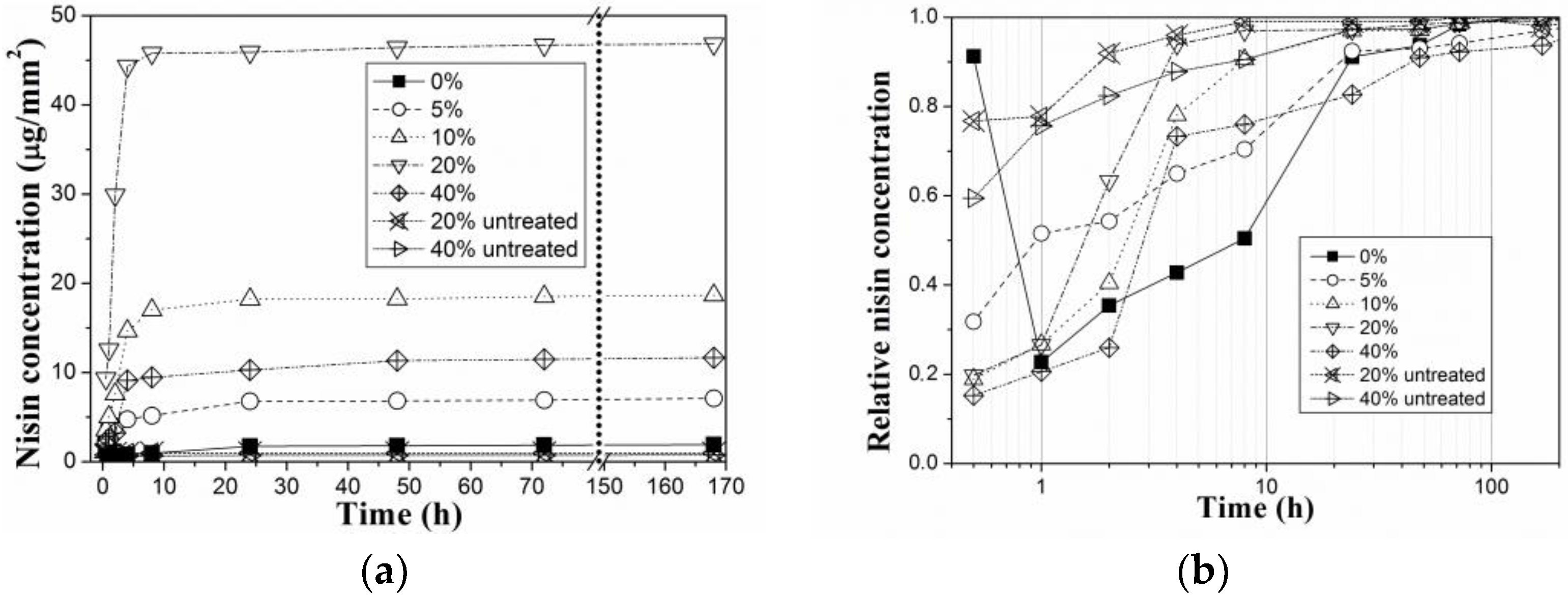
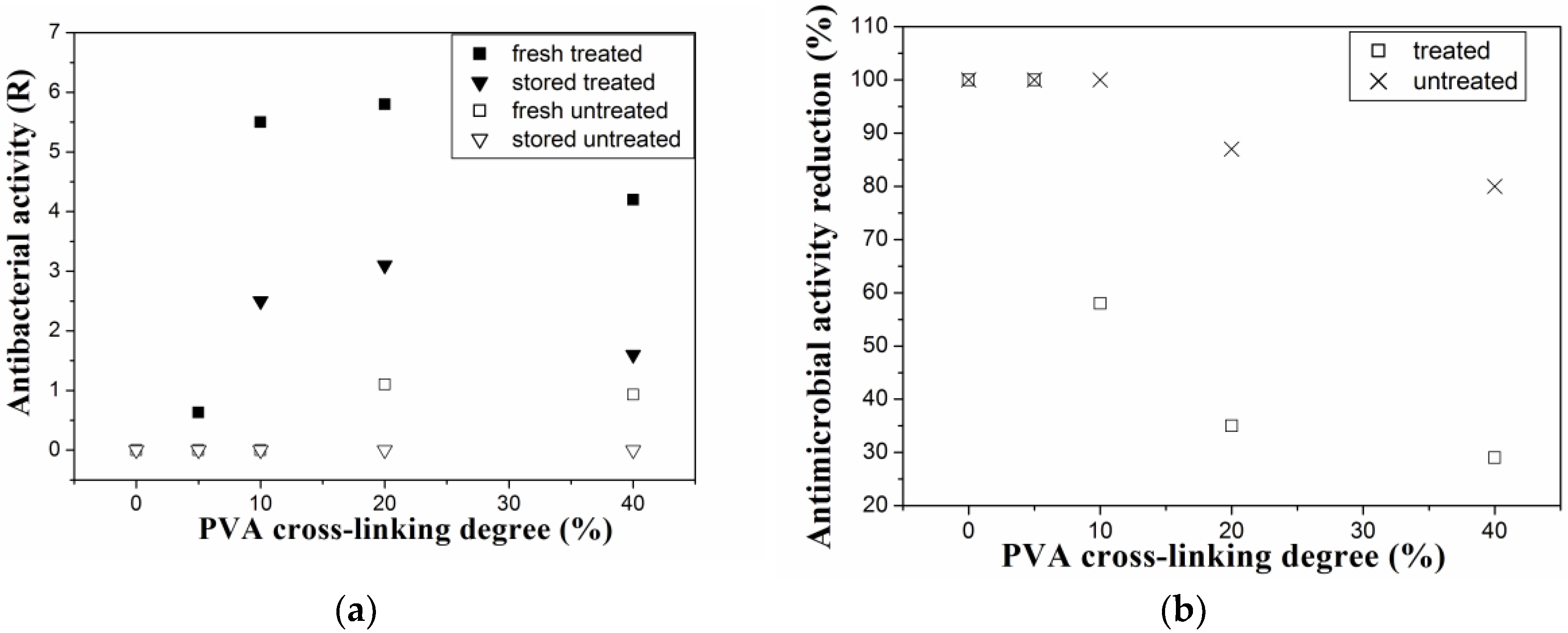
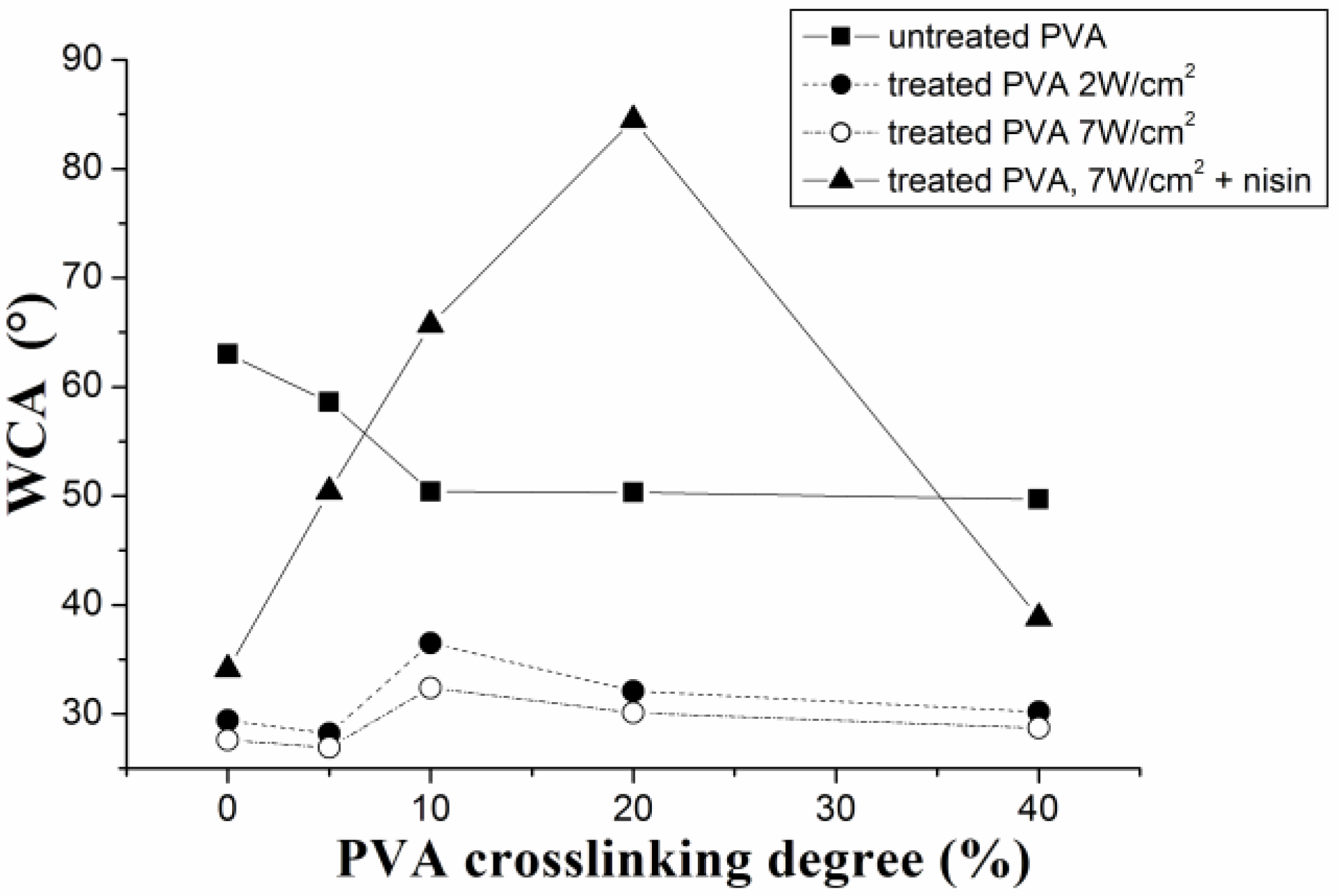
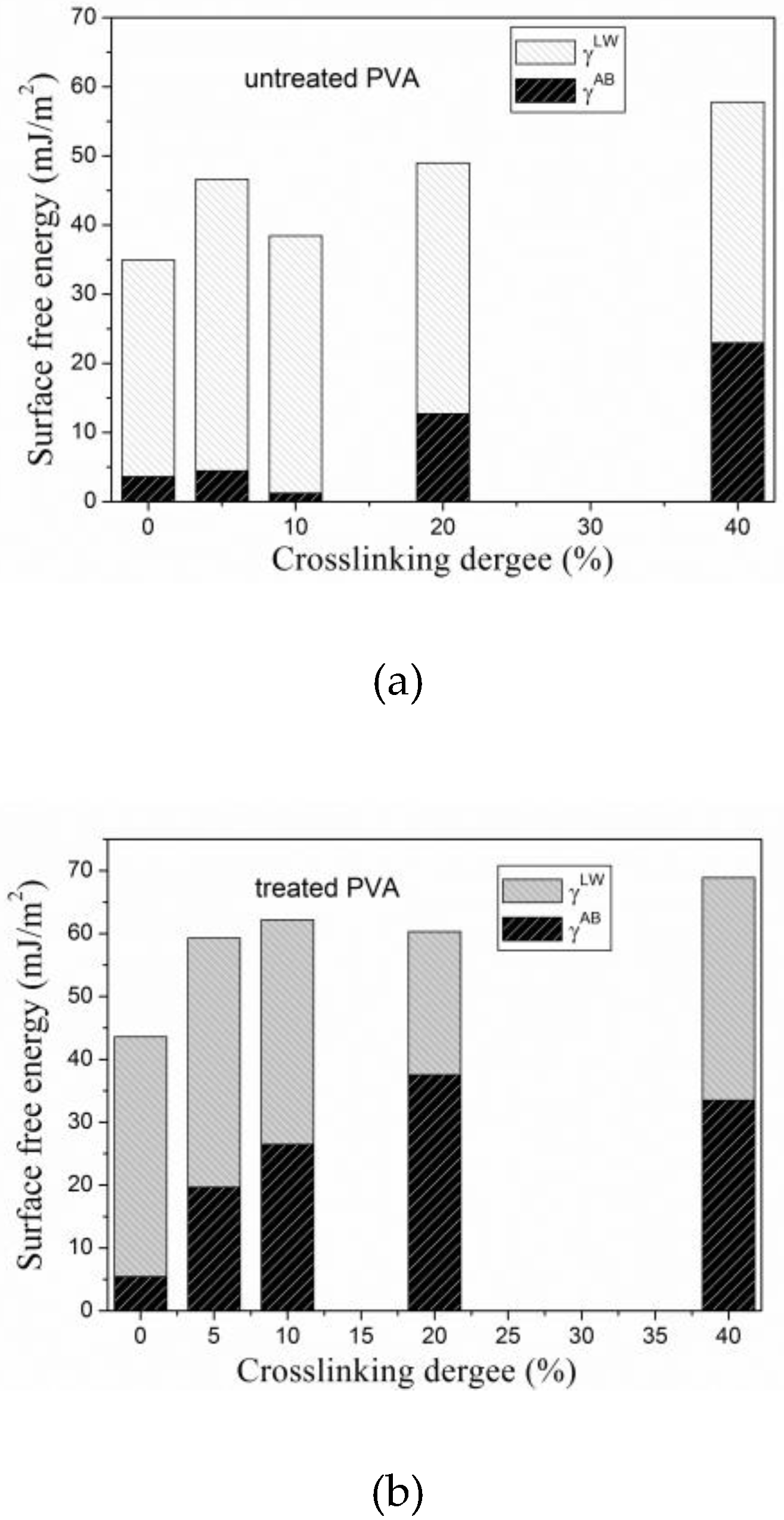
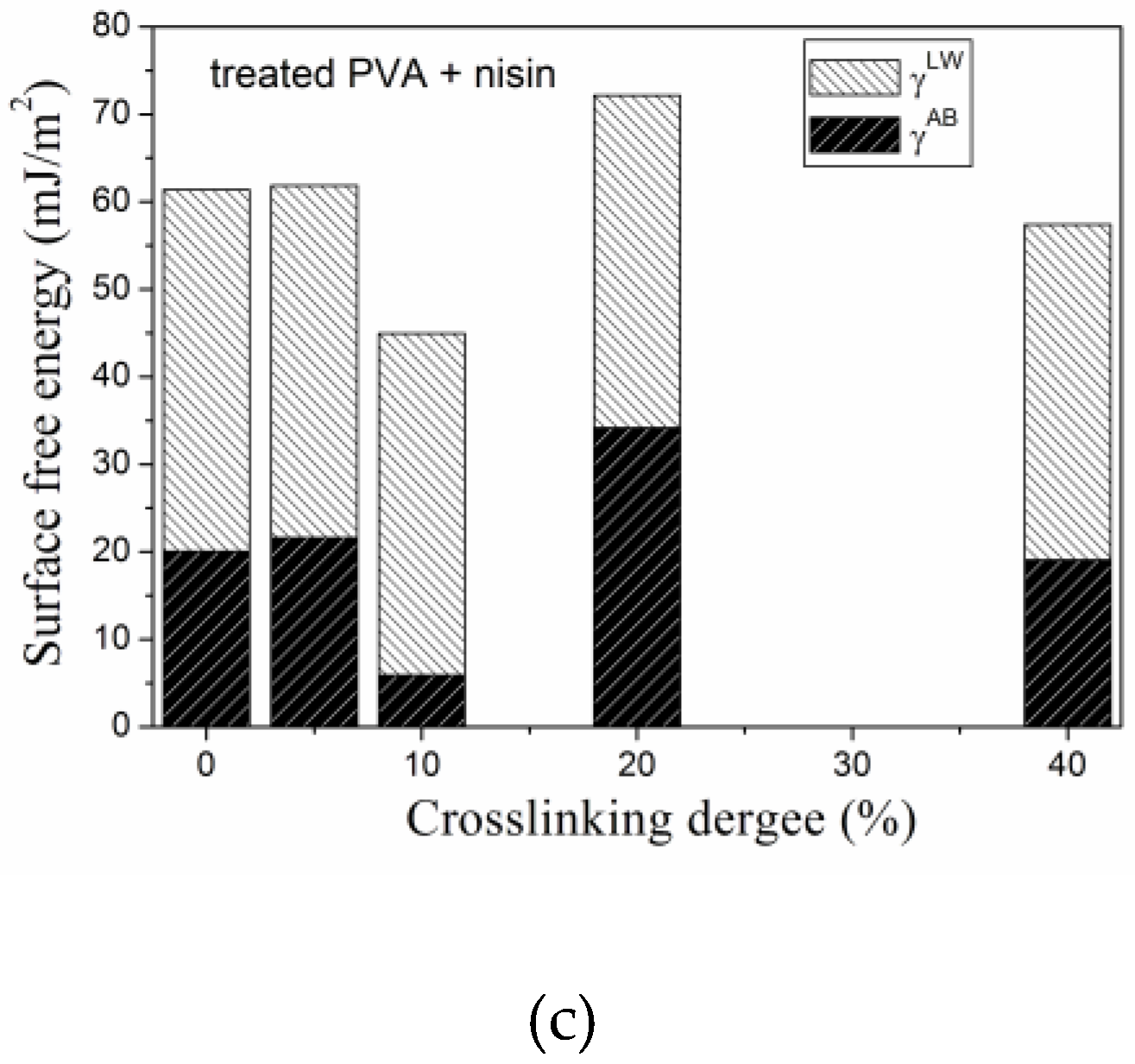
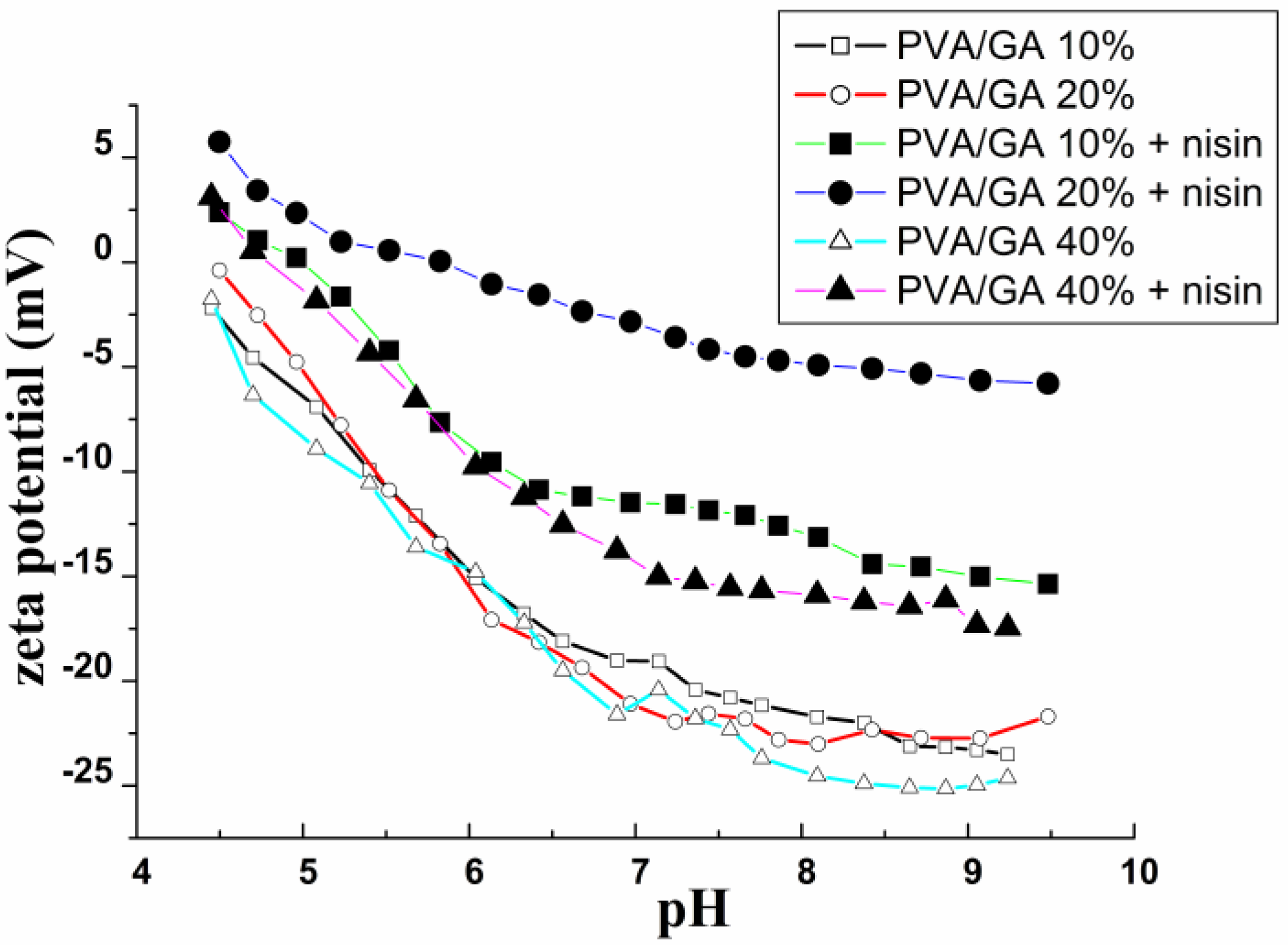
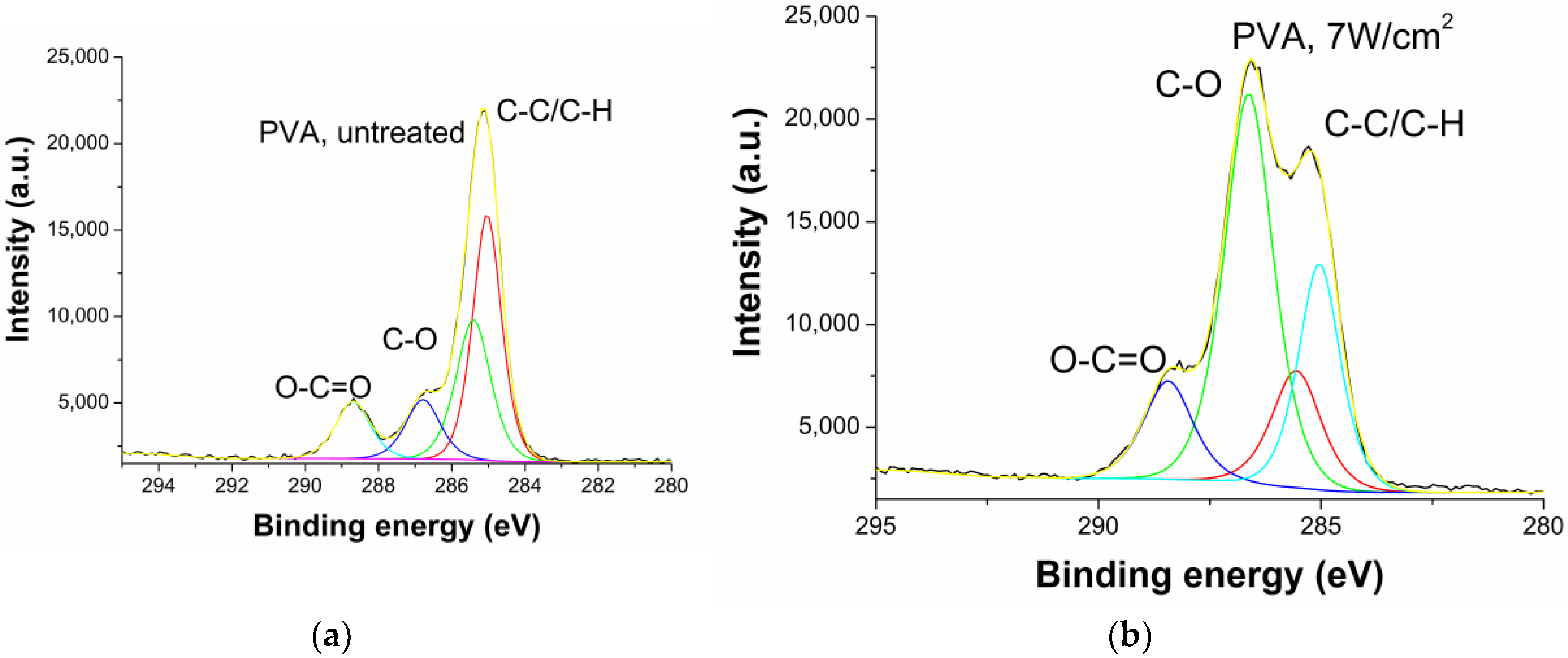
| PVA/Nisin-Buffer Crosslinking Degree (%) | Nisin Content (µg/mm2) | TN (µg/mm2) |
|---|---|---|
| 0 | 1.8 ± 0.5 | 0.7 |
| 5 | 3.6 ± 1.5 | 4.3 |
| 10 | 31.4 ± 1.5 | 13.2 |
| 20 | 28.2 ± 1.5 | 9.7 |
| 40 | 19.3 ± 1.3 | 6.8 |
| PVA + 0% GA | C (at %) | O (at %) |
|---|---|---|
| untreated | 68 | 32 |
| treated 2 W/cm2, 10 s | 38 | 45 |
| treated 7 W/cm2, 10 s | 30 | 51 |
| Bonds (%) | Untreated | Treated, 7 W/cm2 | Treated with Nisin |
|---|---|---|---|
| C–C/C–H | 41 | 31 | 21 |
| C–N | 34 | 36 | 19 |
| C–O | 13 | 15 | 47 |
| C=O | 12 | 2 | 2 |
| N–C=O | 0 | 5 | 11 |
| O–C=O | 0 | 11 | 0 |
© 2018 by the authors. Licensee MDPI, Basel, Switzerland. This article is an open access article distributed under the terms and conditions of the Creative Commons Attribution (CC BY) license (http://creativecommons.org/licenses/by/4.0/).
Share and Cite
Kolarova Raskova, Z.; Stahel, P.; Sedlarikova, J.; Musilova, L.; Stupavska, M.; Lehocky, M. The Effect of Plasma Pretreatment and Cross-Linking Degree on the Physical and Antimicrobial Properties of Nisin-Coated PVA Films. Materials 2018, 11, 1451. https://doi.org/10.3390/ma11081451
Kolarova Raskova Z, Stahel P, Sedlarikova J, Musilova L, Stupavska M, Lehocky M. The Effect of Plasma Pretreatment and Cross-Linking Degree on the Physical and Antimicrobial Properties of Nisin-Coated PVA Films. Materials. 2018; 11(8):1451. https://doi.org/10.3390/ma11081451
Chicago/Turabian StyleKolarova Raskova, Zuzana, Pavel Stahel, Jana Sedlarikova, Lenka Musilova, Monika Stupavska, and Marian Lehocky. 2018. "The Effect of Plasma Pretreatment and Cross-Linking Degree on the Physical and Antimicrobial Properties of Nisin-Coated PVA Films" Materials 11, no. 8: 1451. https://doi.org/10.3390/ma11081451
APA StyleKolarova Raskova, Z., Stahel, P., Sedlarikova, J., Musilova, L., Stupavska, M., & Lehocky, M. (2018). The Effect of Plasma Pretreatment and Cross-Linking Degree on the Physical and Antimicrobial Properties of Nisin-Coated PVA Films. Materials, 11(8), 1451. https://doi.org/10.3390/ma11081451







